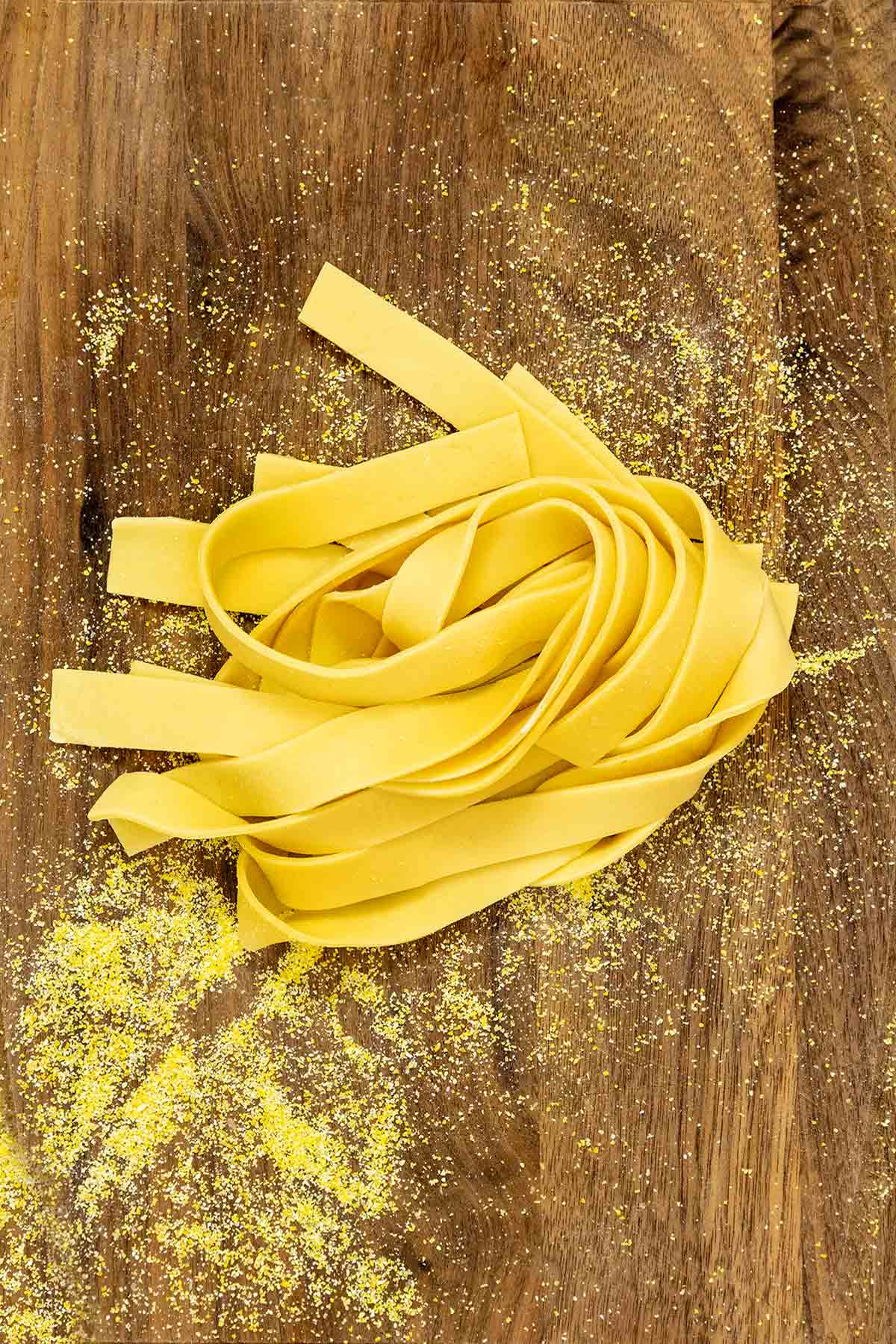
TL;DR (Quick-Answer Box)
- What it is: A traditional, foolproof homemade pasta dough recipe using a blend of “00” flour and semola for a perfectly tender al dente texture + bite.
- Why you’ll love it: Making fresh pasta is wicked simple, and you get a supple, delicious noodle that’s way superior to anything from a box. Six colored pasta variations included.
- How to make it: Combine eggs, flour, salt, and the optional oil. Knead the shaggy dough until smooth, rest it + then roll it with a machine or by hand before cooking. Dress with your favorite sauce.

Jump To
In the canon of Italian cuisine, homemade pasta holds a place of honor. Its delicate texture, versatility, and incomparable taste (Nonna would approve) have made it a favorite across the globe.
Everyone loves pasta–from the Italian duchi of yore to your second-grader to, well, The One. (This man can devour an entire box of pasta in one sitting and has the nerve not to gain weight. The nerve!)
By mastering this basic pasta dough recipe, you’ll have entree into a world of Italian dishes, from beloved spaghetti and classic lasagna to luscious-filled pasta like ravioli, agnolotti, and hearty skillet tortellini dinner.

Why Our Testers Loved This
The delicate texture, effortless process, and tender noodles are just a few reasons our testers call this homemade pasta recipe “a keeper.” Michelle Massey found the dough to be “smooth and elastic” and “beautiful to work with.”
Karen Depp summed it up perfectly with her comment, “This is a straightforward, lovely, easy, basic homemade pasta dough recipe.”
Notes on Ingredients
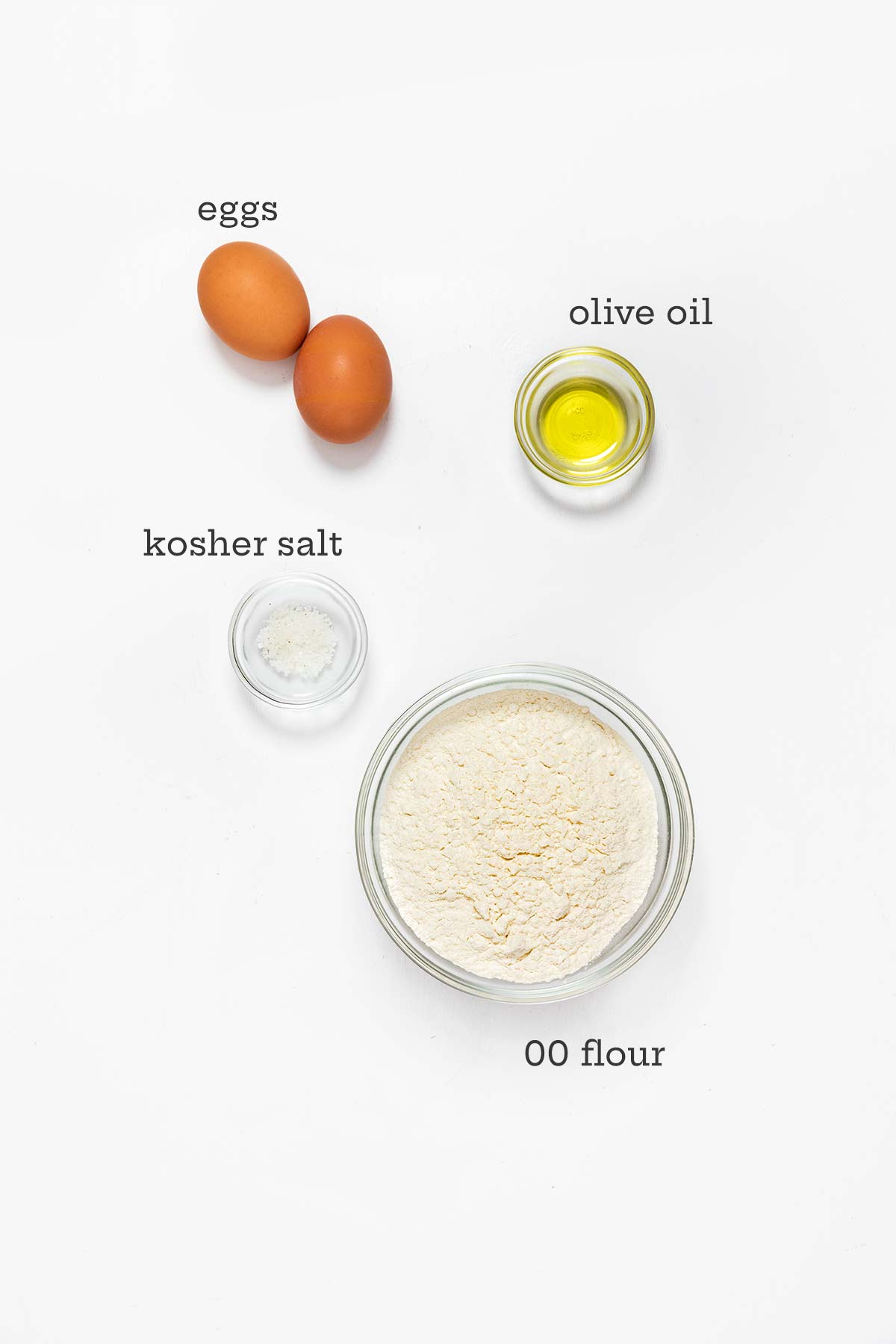
- 00 flour–The fine grain and lower gluten content of 00 flour make it perfect for creating tender pasta.
- Large eggs–Eggs are necessary for creating smooth, pliable pasta and also give the pasta some color. If you need to substitute a different size of egg, then measure by weight (without shells). Two large eggs weigh 3.3 ounces (94 grams).
- Olive oil (optional)–Adding a little oil to your dough will make it easier to roll.
Variations
How To Color Homemade Pasta Dough
- Spinach Pasta
Follow the Basic Pasta Dough recipe. Sift the flour onto a clean work surface. Next, puree 3/4 cup frozen cooked leaf spinach (squeezed to remove as much moisture as possible) in a food processor. Add it to the well in the flour. Continue as per the Basic Pasta Dough method. - Tomato Pasta
Follow the Basic Pasta Dough recipe. Add 2 tablespoons store-bought or homemade tomato paste or sun-dried tomato paste to the well in the flour. Use 1 large egg instead of 2 medium ones. Continue as per the Basic Pasta Dough recipe. - Beet Pasta
Follow the Basic Pasta Dough recipe. Roast 1 red beet until softened, about 45 minutes. Let cool. Peel and grate or puree in a food processor. Add 2 tablespoons grated cooked beet to the well in the flour. Use 1 large egg instead of 2 medium ones. Continue as per the Basic Pasta Dough recipe. - Saffron Pasta
Follow the Basic Pasta Dough recipe. Soak 1 sachet of powdered saffron in 2 tablespoons hot water for 15 minutes. Strain the water, discarding the solids. Use 1 large egg instead of 2 medium ones and whisk with the vibrant saffron water before adding to the well in the flour. Continue as per the Basic Pasta Dough recipe. - Herb Pasta
Follow the Basic Pasta Dough recipe. Add at least 3 tablespoons finely chopped fresh green herbs to the well in the flour. - Squid Ink Pasta
Follow the Basic Pasta Dough recipe. Add 1 sachet squid ink to the eggs and whisk to combine before adding to the flour. You may need to add a little extra flour to the pasta dough.
Visual Step-by-Step Guide: Homemade Pasta
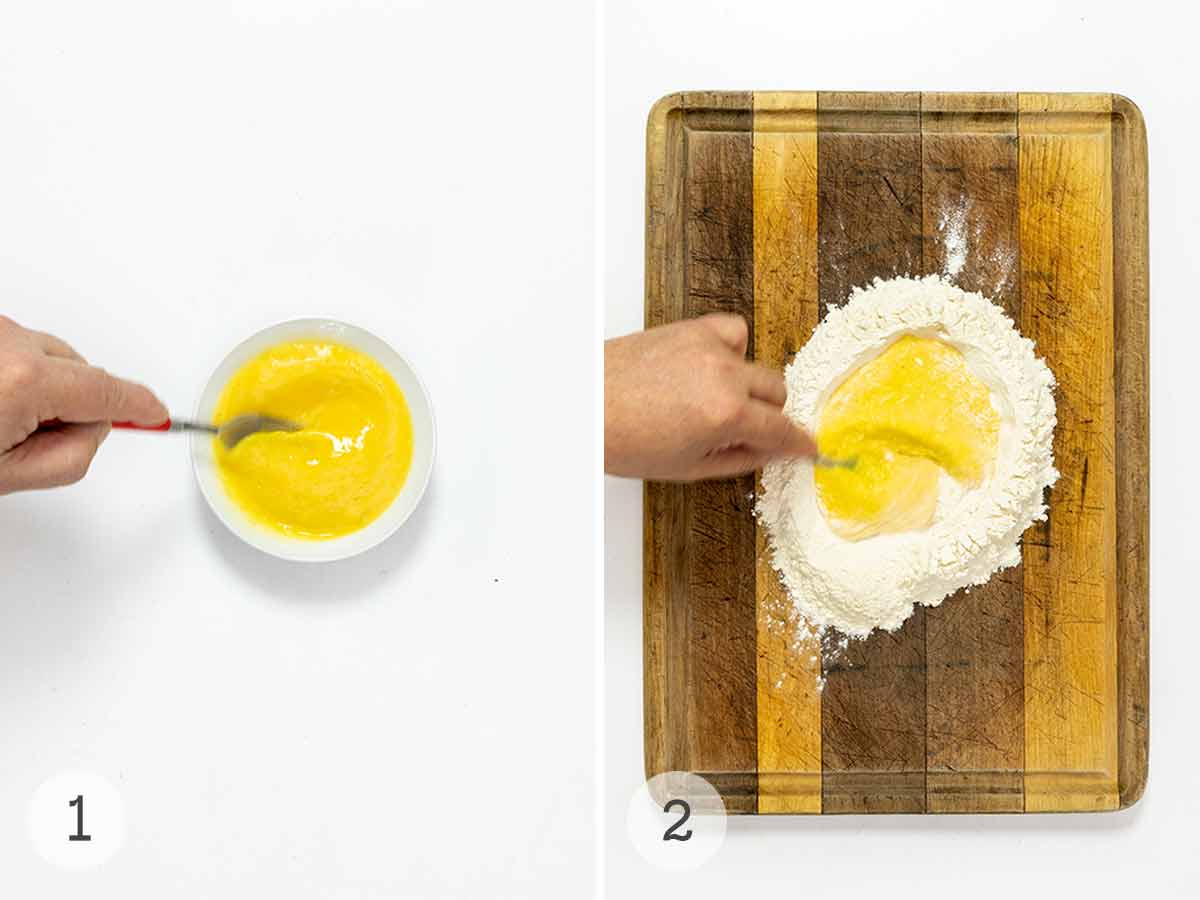
- Beat the eggs in a small bowl. Add the salt and oil, if using.
- Dump the flour on a work surface and make a well in the center. Pour the egg mixture into the well.
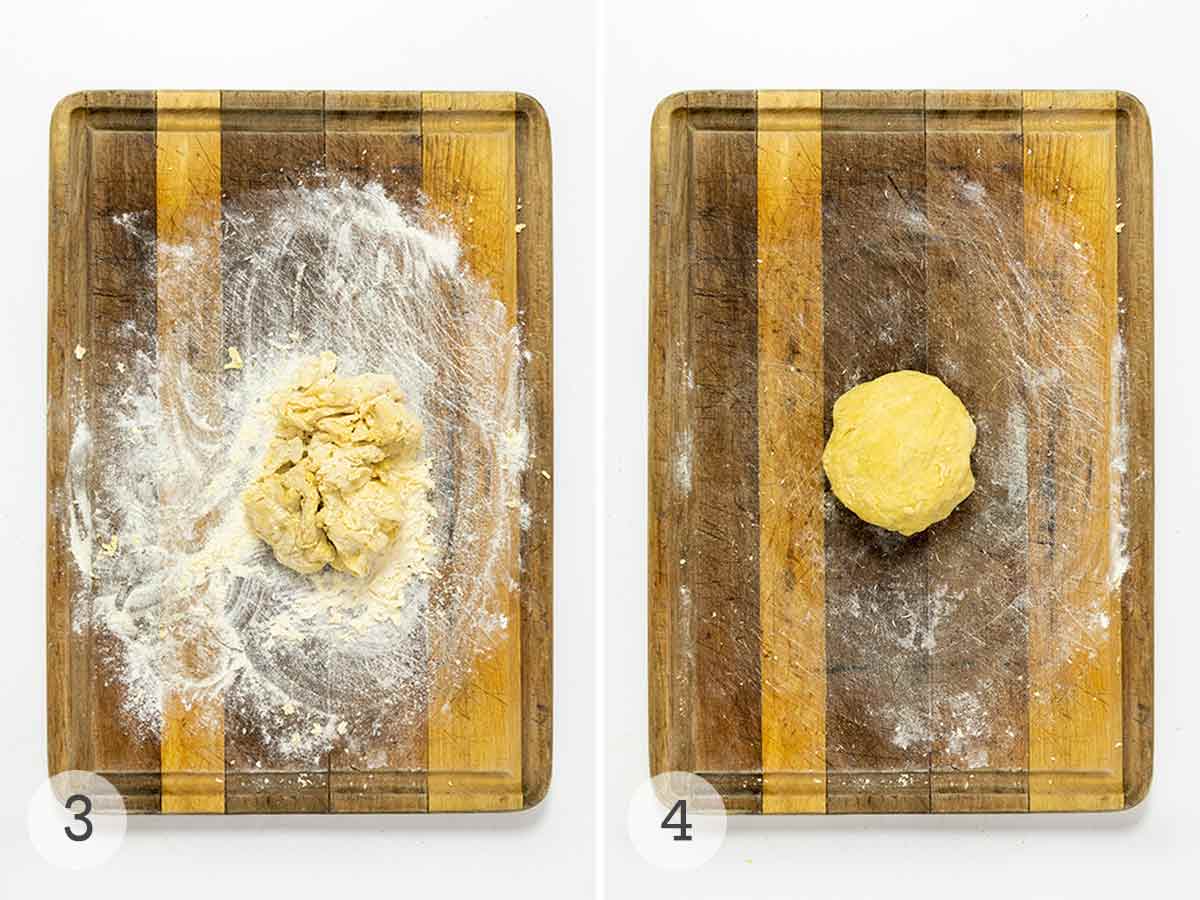
- Mix the flour and egg mixture to create a shaggy dough.
- Continue mixing the dough until it forms a firm dough. Add extra water if dry or flour if wet, as needed.
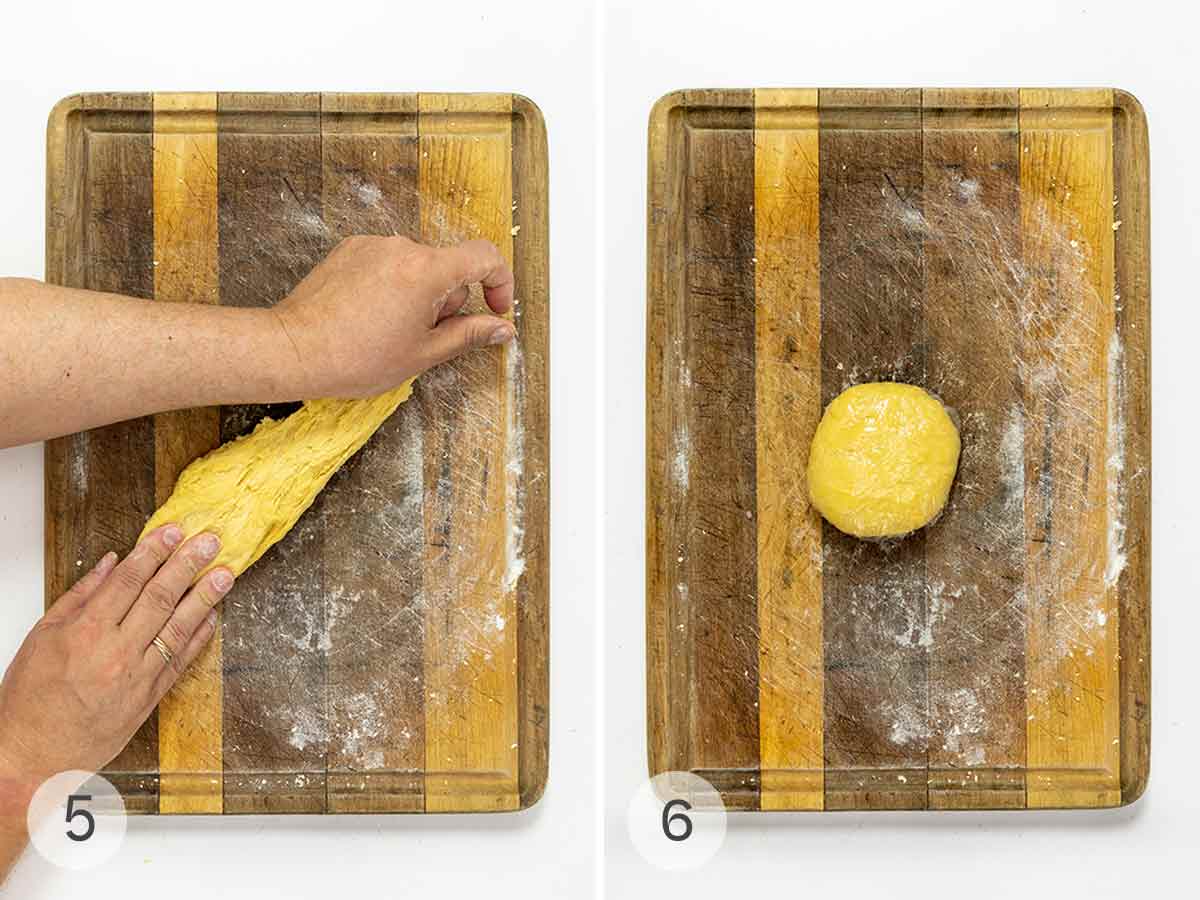
- Knead the dough until smooth. This takes time, and you’ll think it never will come together, but press on, it will. Trust me.
- Wrap the dough in plastic and let it rest for 30 to 60 minutes.
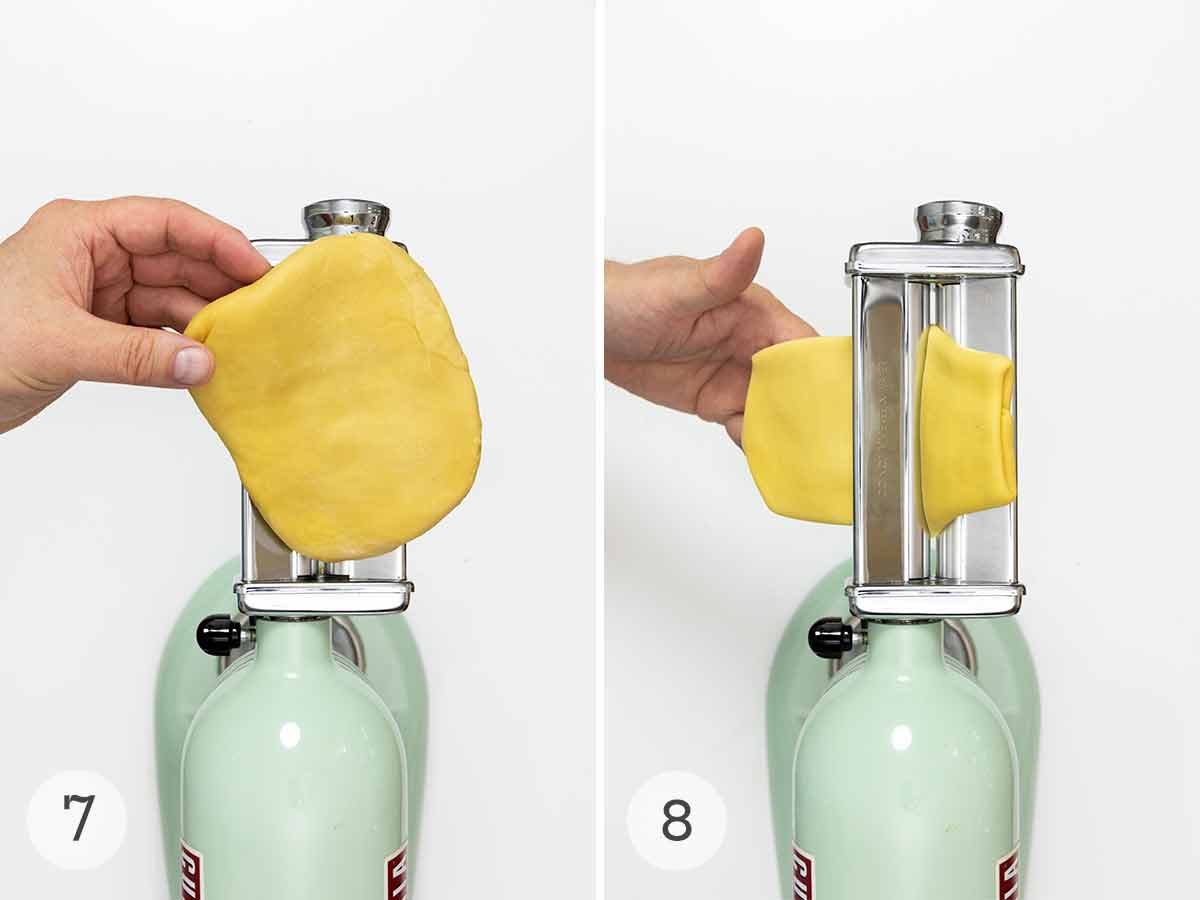
Want to Save This?
- Cut the dough in half. Flatten one dough half into a 1/2-inch-thick rectangle.
- Feed the dough through a pasta roller at its widest setting.
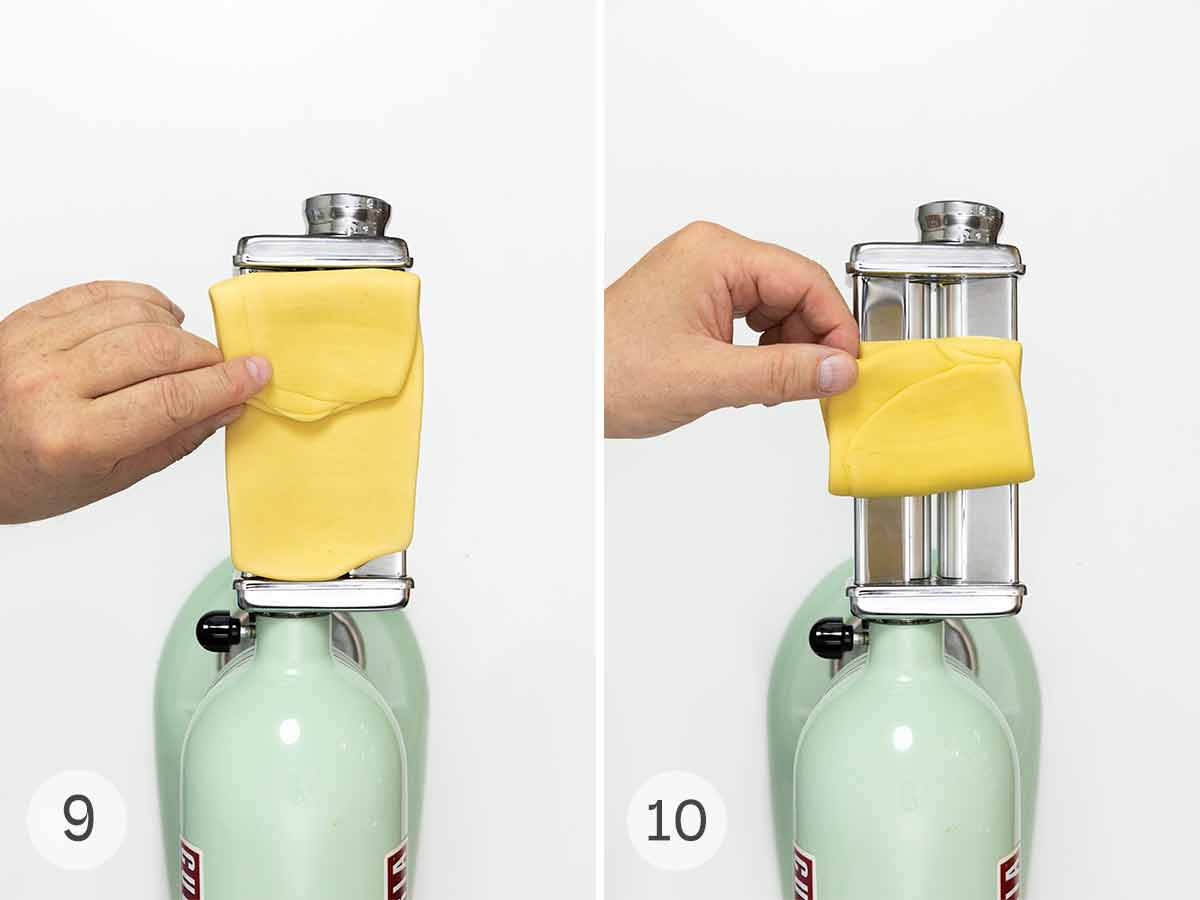
- Fold the dough into thirds.
- Feed the dough through the machine again. Repeat the folding and rolling process several more times. Continue to roll, reducing the thickness to a setting of 5 or 6 for long pasta (pappardelle, tagliatelle, fettuccine, linguine) and 6 or 7 for filled pasta made (ravioli, tortellini, agnolotti, etc.) made by hand, not in a machine.
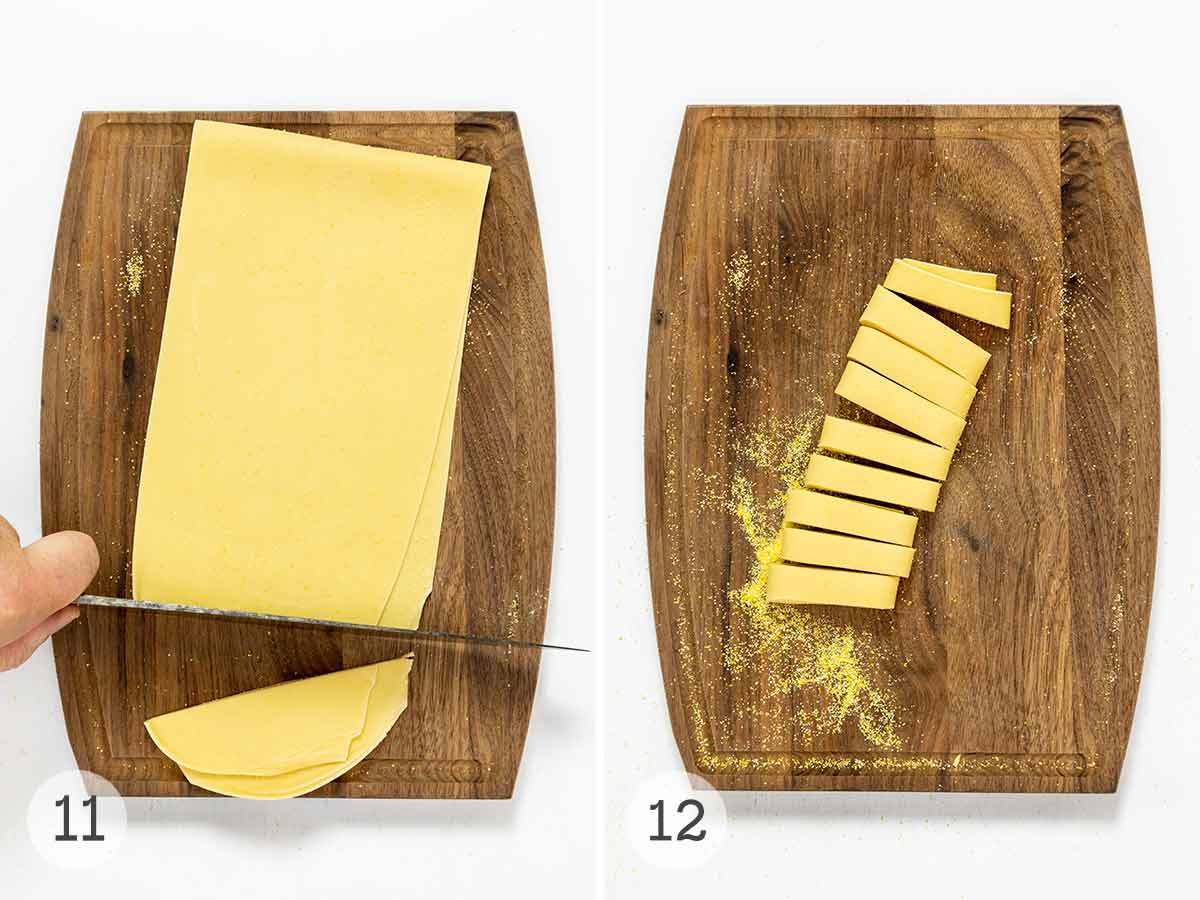
- Generously sprinkle the pasta sheet with cornmeal. (Remember, in this recipe, cornmeal is your friend.) Trim the rolled dough to create a rectangle.
- Loosely roll the dough for easier slicing, then slice it into the desired width.
Common Questions
The magic of this particular recipe can be found in its mixture of 50% Italian “00” flour* (which is lower in gluten than most American flours, it’s an exceptionally light, almost powdery flour that yields dough that is softer and suppler and easier to work with) and 50% Farina di Semola (finely ground, pale yellow, hard durum wheat flour for making pasta and some bread). It can be a little tricky to find 00 flour in some regions, but chances are you’ll find it at most specialty stores, some grocery stores, and, natch, online.
Yes. When properly made, homemade pasta dough has the perfect firmness—but it requires some serious elbow grease when kneading. It can take as long as 10 minutes to knead. You want the dough to come together, be homogenous, and leave no flour on the work surface.
Check the consistency by poking your finger into the dough. A well-rested and hydrated dough should slowly spring back, a sign that it’s elastic and ready to roll. If it feels too soft and flabby, it might be too wet. In that case, knead in a bit more flour. If it’s tough and resistant, it might be too dry. Sprinkle a few drops of water and knead it further.
You sure can, but it will take some patience and one hell of a good arm workout. To roll your pasta by hand, place the dough on a well-floured surface and use a long, stright rolling pin to roll the dough to the desired thickness. Use a pizza cutter or sharp knife to cut it into your preferred shape.
Use it in any of your favorite pasta recipes, or dress it simply with spicy marinara sauce, alfredo sauce, or toss it with a little oil or butter and sprinkle with Parmesan cheese.
This homemade pasta is best used after a brief rest to dry it slightly (“slightly” being the operative word). If you want to store it longer, lightly dust the nests of pasta with the 00 flour and stash them in a resealable plastic bag in the freezer. Cook from frozen.
Great question! About 1 1/2 pounds of fresh pasta equals 1 pound of dry. The extra 8 ounces are made up of the water dry pasta absorbs.
Pro Tips & Troubleshooting
- Don’t worry if the dough seems rough, stiff, and slightly dry after kneading. The rest period helps it to soften and become smooth.
- To scale the recipe, allow approximately 1 egg to 3/4 cup of flour per entrée portion.
- Fresh pasta can be stored in the fridge, wrapped tightly with plastic, for up to 2 days. Freeze individual nests of 00-flour-dusted noodles in resealable bags or airtight containers for up to 4 weeks.
- Fresh pasta cooks way faster than dried, but the exact timing depends on how thick your noodles are. On average, 2 to 3 minutes should be enough to cook freshly-made flat pasta, such as fettuccine, pappardelle, and linguine. After adding the pasta to boiling salted water, stir immediately and frequently to prevent sticking.
- Don’t expect fresh pasta to behave like the dried pasta that you are used to. Fresh pasta is smoother in texture and more tender due to its hydration.
- Fresh pasta is also more delicate than its dried cousin, so treat it more gingerly.
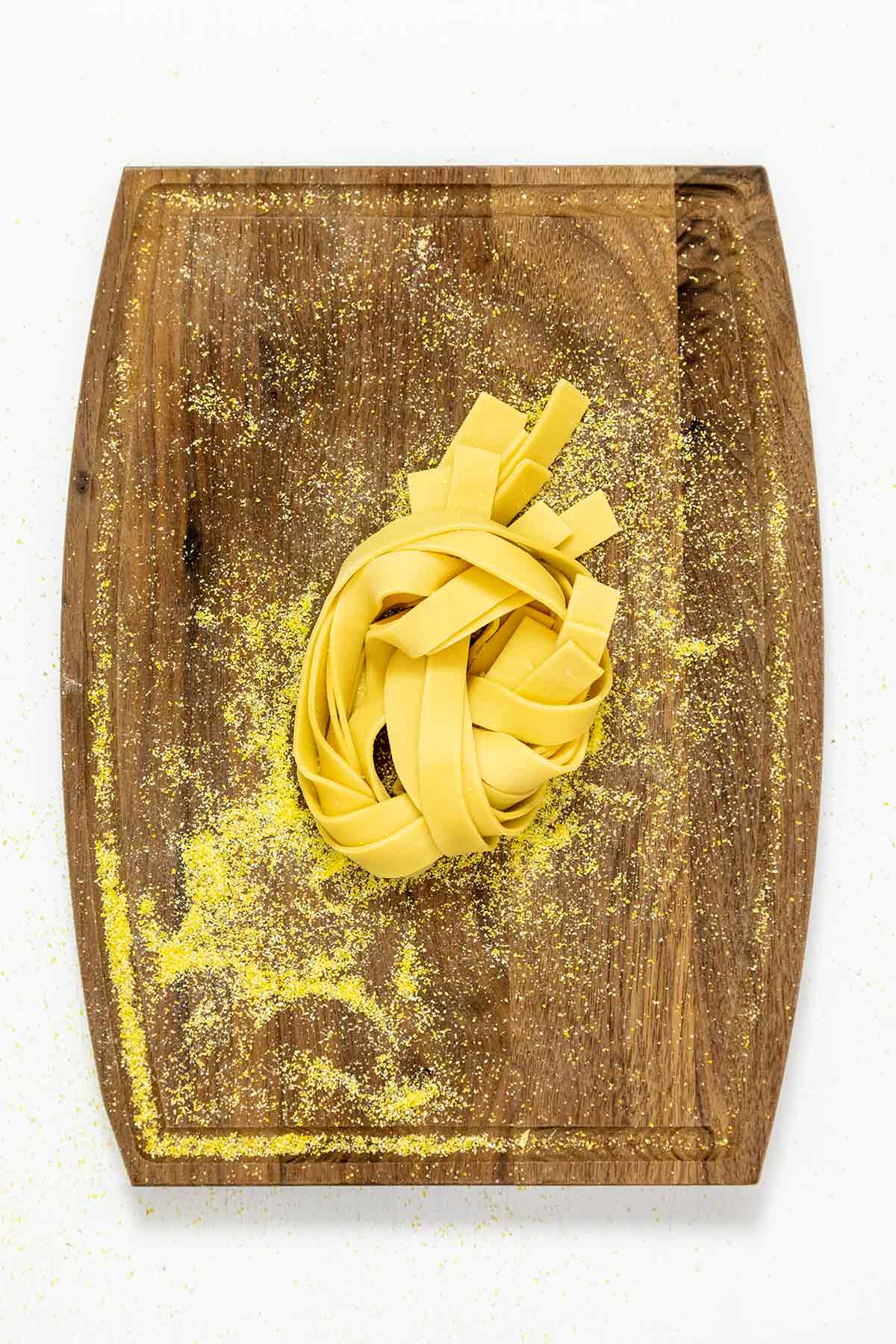
Write a Review
If you make this recipe, or any dish on LC, consider leaving a review, a star rating, and your best photo in the comments below. I love hearing from you.–David
I have tried many pasta recipes and this is the best. The pasta came out silky and luscious.
Pam c.
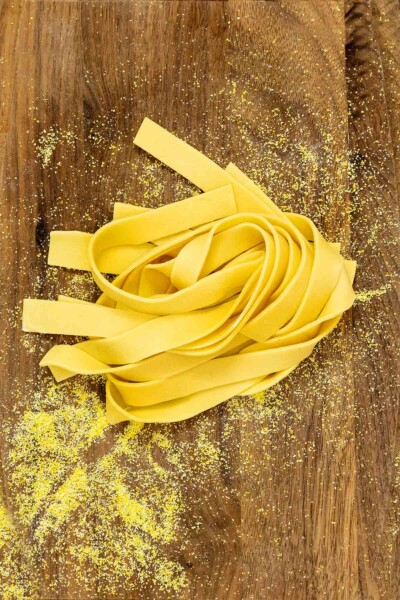
Homemade Pasta Dough
Video
Ingredients
- 1 1/2 cups plus 1 tablespoon Italian "00" flour (or half Italian "00" flour and half farina di semola)
- 2 large eggs
- 1 tablespoon olive oil, optional
- Pinch kosher salt
Instructions
Make the homemade pasta dough
- In a small bowl, beat the eggs well until combined.
- Dump the flour in a pile on a work surface (I like using a wooden cutting board) and make a well in the center with your hand. Pour the eggs into the well. Add the salt and oil if using.
- Using a fork, mix in the flour a bit at a time. Keep adding flour from the well wall and mixing until a firm, shaggy dough forms. If the dough feels dry, add a bit of water; if it feels too wet, sprinkle with a bit of the flour.
- Knead the pasta dough until it’s smooth and homogenous, 5 to 10 minutes. (Keep at it, it takes some muscle!) Roll the dough into a ball, wrap it with plastic, and let it rest at room temperature for at least 30 minutes so it can relax and hydrate.
Pass the dough through a pasta machine/attachment
- Cut the pasta ball in half. Wrap one half in plastic and set aside. Flatten the other half into a 1/2-inch-thick rectangle and carefully feed the dough through a pasta machine set on the widest setting. Once the pasta dough runs through the machine, fold it in thirds and feed it through once more, still on the widest setting.
- Repeat this process of passing the dough through the machine and folding it in thirds 4 more times. This conditions the dough, removes air bubbles, and makes it satiny smooth.
- Continue passing the sheet of pasta dough through the machine, gradually narrowing the setting, one notch for each pass, until the pasta achieves the desired thickness.
- Sprinkle a rimmed baking sheet liberally with cornmeal, lay the pasta sheet on top, and sprinkle with more meal. Let the dough air dry for about 5 minutes while repeating with the remaining pasta half
Cut the pasta by hand
- On a lightly floured cutting board, fold over the pasta in 2-inch sections to create a roll.
- With a sharp knife, cut the pasta crosswise into your preferred width. (I tend to cut these on the generous side.)Pappardelle about 1 inch wideTagliatelle about 1/2 inch wideFettuccine about 1/4 inch wideLinguine about 1/8 inch wide
- Immediately shake loose each bundle and toss it with cornmeal. Place the bundles on the rimmed baking sheet while you boil the water.
Cook the fresh pasta
- Bring 3 to 4 quarts of well-salted water to a boil. Toss in the pasta bundles, stirring to prevent the noodles from sticking to each other. Cook until al dente, 2 to 3 minutes, depending on the width and thickness of the pasta.
- Reserve 1/4 cup of the pasta water (it helps to emulsify the sauce you use) and drain the pasta.
- Return the pasta to the pot, stir in your sauce of choice. Dribble in a bit of pasta water–only if needed. Serve immediately with grated cheese.
Notes
- Don’t worry if the dough seems rough, stiff, and slightly dry after kneading. The rest period helps it to soften and become smooth.
- To scale the recipe, allow approximately 1 egg to 3/4 cup of flour per entrée portion.
- Fresh pasta can be stored in the fridge, wrapped tightly with plastic, for up to 2 days. Freeze individual nests of 00-flour-dusted noodles in resealable bags or airtight containers for up to 4 weeks.
- Fresh pasta cooks much faster than dried pasta, but the exact timing depends on how thick your noodles are. On average, 2 to 3 minutes should be enough to cook freshly-made flat pasta, such as fettuccine, pappardelle, and linguine. After adding the pasta to boiling salted water, stir immediately and frequently to prevent sticking.
- Don’t expect fresh pasta to behave like the dried pasta that you are used to. Fresh pasta is smoother in texture and more tender due to its hydration.
- Fresh pasta is also more delicate than its dried cousin, so treat it more gingerly.
Explore More with AI
Nutrition
Nutrition information is automatically calculated, so should only be used as an approximation.
Recipe Testers’ Reviews
This is a straightforward, lovely, easy, basic homemade pasta dough recipe. I made it with my 9-year-old granddaughter, who became a master of cranking the pasta machine.
I hunted down the Italian 00 flour and the farina di semolina so that we could test the proper flours. It took only 1 to 2 minutes to knead the dough. We made the basic medium-wide noodles and will make the pasta dough again to try some of the other shapes.
All in all, it was a great hit for dinner with a hint of butter, chopped Italian flat-leaf parsley, and freshly grated cheese. It’s definitely a keeper.
This is a homemade pasta recipe that works.
I used a 50/50 mix of Italian 00 flour and semolina. It took some kneading to get the dough to come together at first, so I can see how one might need extra water. I only kneaded it for 5 minutes, and after that, the dough was stiff but cohesive—there were no hanging straggly parts or anything like that.
I find pasta dough benefits hugely from resting, so I didn’t knead it any further.
I did have to use the thickest setting of the pasta roller for the first pass (I used my KitchenAid attachment, not the manual crank one), but after that, the homemade pasta dough rolled out very nicely, even when using the second-thinnest setting.
I served it lightly sauced alongside some Italian sausage and sautéed greens.
This pasta dough recipe yielded beautiful pasta with a delicate texture. This dough made beautiful pasta, which my family thoroughly enjoyed. I will definitely make this again.
I kneaded it for about 5 to 7 minutes and still wasn’t sure if the dough was going to be too dry, but I massaged the outside of the dough with a little olive oil and wrapped it in plastic. Half an hour later, I had a mound of homemade pasta dough that felt ready to work with. The rest time really did help.
This recipe was my first attempt at semola pasta made from scratch, and I was very pleased with the results.
I used half 00 flour and half semola and adjusted the recipe for flavored pasta. I added 2 tablespoons of pureed carrots, and it was delicious with spicy sausage and a creamy tomato sauce. The pasta dried much more quickly than egg pasta, which made cutting it into linguine much easier as there was no sticking. I can’t wait to try other flavors!
The homemade pasta dough came together beautifully, though next time, I’d omit the oil. After a 5-minute kneading, the dough was smooth and elastic but needed a little rest. When I rolled it out in the pasta maker, it was beautiful to work with.
I cut the sheets into pappardelle, but when cooking, I pulled the noodles out before they were ready, at about 5 minutes, then sautéed them in a pan with ramp bulbs, butter, and a bit of the cooking water. I served this with toasted bread crumbs and loads of cheese.
I’d totally make this again—this dough was so effortless that I’d only bother freezing this if I was making stuffed pasta, like ravioli. In my testing, I doubled the recipe and used half semolina flour.
I also had some ramps, so I blanched the greens and used them like you would in the recipe’s spinach variation. The amount of ramp greens I had was well under the 3 to 4 cups of spinach called for, but the bossy flavor of the ramps more than made up for it. The color was pale mint green with flecks.
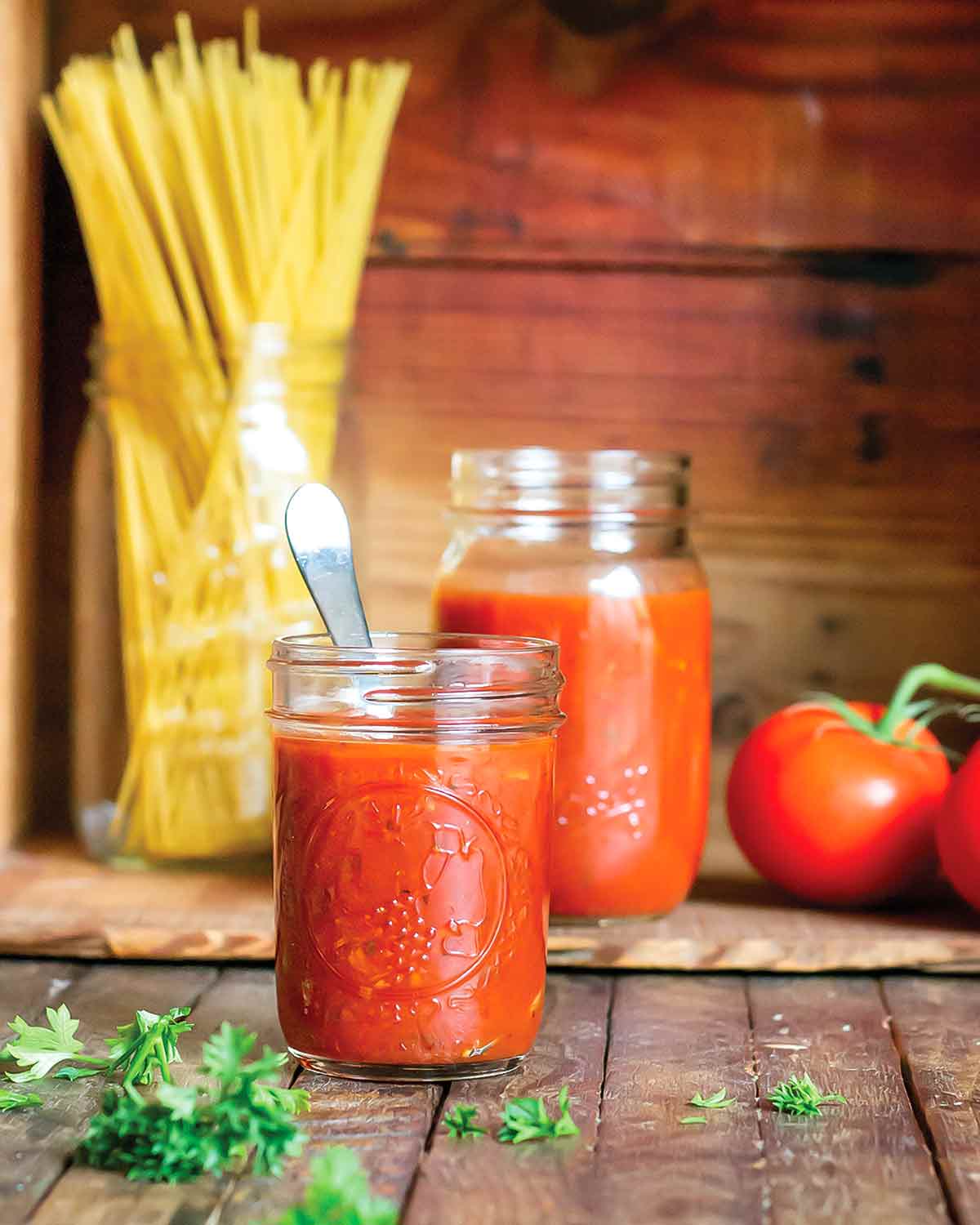














Great recipe! it was the first time my boyfriend and I made pasta—the recipe was super easy to follow and we rolled out the pasta since we don’t have a machine to do it for us. We made raviolis on Sunday, loved how it turned it, and ended up making pappardelle tonight! Thank you!
Diana, you are so very welcome! I love everything about what you just shared with us. Thank you so much for taking the time to let us know! You absolutely made my day because this is exactly why we do what we do—so that home cooks can have experiences just like yours. Looking forward to hearing which recipe on the site you try next!
Just a quick note for anyone who doesn’t have a pasta machine. My brother and I are avid pasta makers and got tired of schlepping our pasta machines in and out of cabinets. So we learned via internet videos (and lots of trial and error) how to roll it out using rolling pins. It isn’t difficult to do although it does take some practice to get the sheets “see through” thin and it’s much easier to accomplish with an extra long straight-sided pin. Bonus points for the meditative aspect of rolling and a certain amount of creative freedom to do what you want with a sheet of dough that covers the counter top. Thanks for the recipes for flavored pastas!
Lyn, I absolutely love that you roll out the pasta by hand and consider it a little quiet time. Thank you so much for sharing! I’m curious, have you happened upon any particular tricks that you’ve found to be critical that you’d like to share…?
Hi. Happy New Year!! If I’m making fresh pasta for a crowd, how do I keep it from sticking until I’m ready to cook?
How far ahead of time will you be making the pasta, Donna?
I’d like to make it in the morning or the night before.
Donna, if you’re making a long shape of pasta, I suggest curling the strands into nests on rimmed baking sheet lined with parchment and lightly dusted with flour. Cover it and refrigerate it.